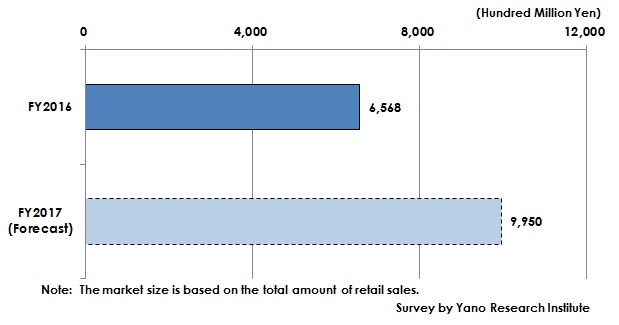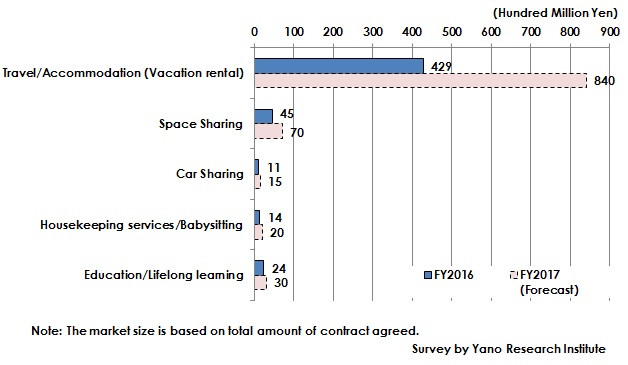No.1883
C2C Market in Japan: Key Research Findings 2018
C2C Market in Japan: Key Research Findings 2018
Yano Research Institute (the President, Takashi Mizukoshi) has conducted a survey on the domestic C2C market and has clarified the current status, trends of the market players and the future outlook.


Market Overview
The C2C (consumer-to-consumer) market in FY2016 has shown expansion from the last fiscal year especially in the category of product sales by large businesses of flea market apps, such as Mercari, allowing buying and selling things online between consumers as the awareness of the apps has improved primarily among youngsters and housewives. Also, enterprises have increasingly entered C2C businesses in the areas of travel/accommodation (vacation rental) and space sharing, against the backdrop of hotels and pay-by-the-hour parking spaces being short of properties and spaces.
The C2C market in product sales in FY2016 is estimated as 656,800 million yen, based on the total amount of retail sales. The C2C market in the category of services has been estimated as 42,900 million yen for travel/accommodation (vacation rental), 4,500 million yen for space sharing (rental of parking lots, farm lands, and vacant spaces), 1,100 million yen for car sharing, 1,400 million yen for housekeeping services/babysitting, and 2,400 million yen for education /lifelong learning.
Noteworthy Topics
In recent years, there are many cases where those enterprises dealing in secondhand items enter the C2C market.
Entry by such enterprises in the area of product sales seems to stem from rapid growth of flea market apps which has given opportunities for consumers to directly sell and purchase secondhand products, which, in turn, has reduced and threatened the business of the enterprises dealing in secondhand goods. Especially, those consumers who are youngsters and housewives have started using C2C services as a means to get rid of their belongings. Such changes in the consumer trends encouraged those businesses to enter the market and acquire the demands from those consumers.
Some such dealers and traders that handle secondhand vehicles and luxury brand items provide various value-added services in the C2C market, such as to judge whether the product brands are real or not, to securely send and transfer the products to the receivers, and etc. Also, they provide C2C services at their own company websites. They are trying to differentiate with existing C2C services by taking advantage of their own facilities such as distribution centers and sales channels.
Future Outlook
When considering that the C2C market makes the secondhand items and services available between consumers at low cost, there are no competitions in the existing markets, and therefore, the market is likely to continue growing.
In the C2C market, with the users likely to increase, the market is expected to be invigorated more for the coming future. For example, in the category of product sales, some original products such as creation of a person can be sold and bought more. In the category of services, the area of skill sharing is promising to grow, since it needs no capital such as products or buildings but just the knowledge, experience, and skills of a person to provide, so that the services can be exchanged casually.
On the other hand, the C2C market has some categories that may shrink, such as home fashion products and products for kids and babies. The former because existing enterprises provide more convenient services, such as purchasing at the sellers’ home, and the latter because the buyer population is decreasing against a backdrop of declining birth rate.
Also, in the category of services, there are some services, such as vacation rental, that can expect more demands but may eventually scale down in the C2C market, because revisions and regulations may be imposed to the existing laws to restrict the providers only to enterprises and to make it impossible to provide the services by an individual.
Research Outline
2.Research Object: C2C Service Operators/Providers
3.Research Methogology: Face-to-face interviews by the expert researchers, survey via telephone/email, and literature research
What are the C2C (Customer to Customer) Markets?
The C2C (Customer to Customer) market in this research indicates the market that allows a consumer to directly interact with other consumer customers. This includes an interaction of selling/buying of one’s belongings, or of asking/providing of a service. Also, C2C business in such a market indicates that the market players only provide the platform of interactions, and do not provide any instructions for or do not participate in the sales management.
Note that this research does not include the entire C2C market. It basically includes only those dealt through the platforms available on the internet (apps/website). Therefore, no dealings at a real marketplace or an actual flea market are included, and no financial services and premium ticket trading between individuals are included.
Published Report
Contact Us
The copyright and all other rights pertaining to this report belong to Yano Research Institute.
Please contact our PR team when quoting the report contents for the purpose other than media coverage.
Depending on the purpose of using our report, we may ask you to present your sentences for confirmation beforehand.